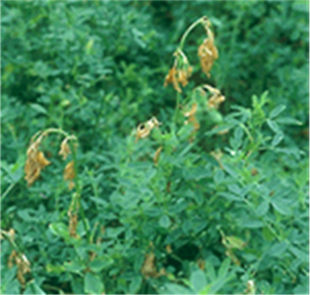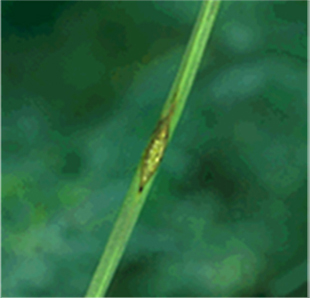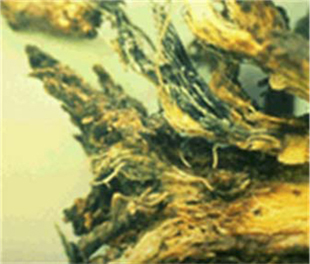G2081
Alfalfa Anthracnose
Anthracnose causes stress and yield and stand loss in alfalfa. Understanding the symptoms, disease cycle and management strategies can help reduce the disease’s impact.
Stephen N. Wegulo, Extension Plant Pathologist
Bruce E. Anderson, Extension Forage Specialist
|
Alfalfa is an important forage crop in Nebraska. In 2010, 3.7 million tons of forage alfalfa were harvested from 895,000 acres. High feed and forage production costs and periodic droughts have generated increased concern by farmers and ranchers over forage losses from diseases, insects, and environmental stresses.
Anthracnose and Phytophthora root rot are the most serious alfalfa diseases in Nebraska. Although anthracnose often is singled out as a separate problem, it is only one of several factors affecting plant health. It interacts with other diseases and with environmental factors to produce a cumulative stress that causes yield and stand loss.
Anthracnose of alfalfa is caused by Colletotrichum trifolii. This fungus can attack leaves but most characteristically attacks stems and crowns.
Symptoms
Anthracnose can appear anytime during the growing season and on stands of any age. It typically appears after the second cutting and on stands two or more years of age, but it has occurred on seedlings in early summer before the initial cutting.
From a distance, affected fields show dead, straw-colored stems scattered throughout the stand. Infected stems are curved at the tip similar to a shepherd’s crook (Figure 1). Leaves wilt, turn tan, and the entire stem dies.
At first only a few, individual stems on scattered plants are affected; but on susceptible varieties, the disease progresses rapidly, affecting 30 to 50 percent of the plants within the crop canopy by the one-tenth bloom stage.
Typical stem lesions are diamond-shaped and ash-gray in color (Figure 2). They have a dark-brown to purple border and usually form on the lower stem. The gray centers of the lesions are dotted with small, black fruiting bodies of the fungus. More than one lesion may be found randomly distributed along the stem.
Lesions may coalesce and girdle the stem, resulting in wilt and subsequent death. Those occurring just above the crown may not have the typical diamond shape.
The anthracnose fungus may advance downward from the infected stem into the crown tissues. Infected crowns appear bluish-black near the origin of the stems and reddish-brown near the inner crown tissues (Figure 3). Crown symptoms may be present without the presence of stem lesions.
Major reductions in stand occur when anthracnose crown rot is widespread within a stand. Infected plants usually die within one or two seasons after invasion of crown tissues. Plants may be killed outright by the disease, or by cold winter temperatures because of reduced cold tolerance. Many die during the winter and fail to initiate growth the following spring. When this occurs, plants should be dug, cleaned, and the crowns examined for evidence of anthracnose.
Disease Cycle
The anthracnose fungus persists on or in plant debris in the field or on harvesting equipment. Stacked hay also serves as a potential source of fungus inoculum.
With warm, wet weather, spores are produced on stems and spread from stem to stem and plant to plant by wind, splashing rain, or irrigation water. Spores are carried down into crowns during rain, irrigation, or heavy dew formation; or the fungus may grow down from stem infections into crown tissues.
Dissemination from one field to another is by wind-blown spores or by the movement of infected stems on machinery. Anthracnose is not spread through seed.
Anthracnose is most active in Nebraska from July through September. It is most severe on late harvests during warm days with cool nights accompanied by heavy dew.
Anthracnose differs from other alfalfa crown rots in that it renders fields unproductive within one or two seasons. Crown rot caused by Fusarium spp. and other fungi results in a more gradual stand decline. For more information on these crown rots, consult NebGuide G2080, Alfalfa Crown and Root Rots and Stand Longevity.
Management
Planting alfalfa varieties resistant to anthracnose is the most effective strategy for preventing forage and stand losses. Many of the improved varieties now have acceptable levels of resistance to anthracnose.
Nebraska producers are strongly urged to plant varieties resistant or highly resistant to anthracnose, Phytophthora root rot, and bacterial diseases. These are the three major diseases that contribute to early stand decline and loss in forage production.
Information on variety, disease, and insect resistance and performance in Nebraska is available in Extension Circular EC153, Selecting Alfalfa Varieties for Nebraska 2008.
Cleaning debris from haying machinery before the first cutting in spring and during the growing season can help to prevent introduction of the anthracnose fungus into clean fields. Spread of anthracnose also can be reduced by mowing young stands before old stands.
Fields with a previous history of alfalfa crown rot should be rotated to another crop for at least two years before being replanted to alfalfa to reduce fungus inoculum.
Good management and avoidance of stress on the crop, where possible, will help to reduce yield loss.
Acknowledgments
John E. Watkins co-authored the previous version of this NebGuide.
This publication has been peer reviewed.
Visit the University of Nebraska–Lincoln Extension Publications website for more publications.
Index: Plant Diseases
Field Crops
Issued June 2011


